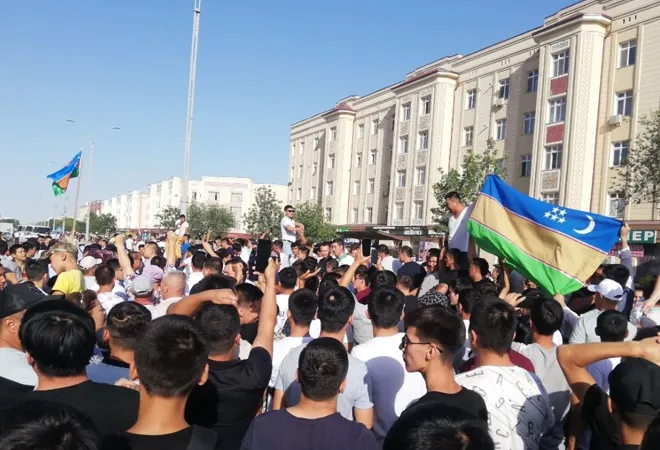
Uzbekistan has been plunged into chaos recently as protests erupt in the autonomous region of Karakalpakstan. Protests broke out in the regional capital of Nukus, followed by other cities, in response to proposed changes to the Uzbek Constitution by President Shavkat Mirziyoyev, who has been trying to reform constitutional norms since 2016. The current changes essentially sought the removal of language within the Constitution which guaranteed the right of semi-autonomous Karakalpakstan to secede from Uzbekistan, should its population choose so in a referendum.
In what is being called the worst bout of violence in the Central Asian nation
since the Andijan massacre in 2005 when the police attempted to quell anti-government protests, killing 187 people, the Uzbek authorities have reported 18 people dead and at least 243 injured over a week. Whilst efforts are being made to stabilise the situation with the President publicly dropping his plans to make the changes in the Constitution, the situation remains rather unstable as symbolised by the imposition of a month-long insurgency in the province of Karakalpakstan.
The Parliament in Karakalpakstan adopted a declaration of state sovereignty in 1990, but it was short-lived as the region was officially incorporated within Uzbekistan in 1993.
Background
Following the dissolution of the USSR, there were a lot of breakaway movements through its former territories, Karakalpakstan being one of them. The Parliament in Karakalpakstan adopted a declaration of state sovereignty in 1990, but it was short-lived as the region
was officially incorporated within Uzbekistan in 1993. However, the Uzbek authorities provided the option for a referendum to take place in 20 years. The region also has a separate Constitution, and Article 1 of the same recognises the independence of the region. The Republic of Karakalpakstan has all the national symbols of a sovereign state, i.e., a flag, a state emblem, and an anthem.
Even though Karakalpakstan
occupies roughly 37 percent of Uzbekistan, ethnic Karakalpaks represent about a third of the region’s population and around 2.2 percent (according to 2017 government estimates) of the country’s population. The Karakalpaks are mainly Sunni Muslims, who are culturally and linguistically related to the Kazakhs.
Karakalpakstan is one of the most adversity-stricken regions of the country, with extremely high of poverty, unemployment, and also poor health to the dried-up Aral Sea leaving behind a tremendous amount of toxic dust that is a combination of salt and pesticides. This has led to the spread of diseases such as cancer, tuberculosis, and anaemia, further exacerbating the poor economic situation in the region.
Nevertheless,
since coming to power, Mirziyoyev had facilitated substantial
investments in the region, beyond just the capital town of Nukus into smaller pockets like Moynaq, Turtkul, and Kungrad. Things seemed to be improving as the region had started integrating better with the rest of Uzbekistan and also with Kazakhstan and Russia, with many travelling to these countries for work.
Karakalpakstan is one of the most adversity-stricken regions of the country, with extremely high of poverty, unemployment, and also poor health to the dried-up Aral Sea leaving behind a tremendous amount of toxic dust that is a combination of salt and pesticides.
The trust and goodwill that might have been developing between the people of the region and the government due to certain improvements are likely to take a backseat following this recent announcement. Eurasia expert Jennifer Brick Murtazishvili
writes that this impoverished region would not be able to afford independence and is very dependent on financial transfers and investments from Tashkent, making it very difficult to understand the government’s current decision. Moreover, she adds that although there is some sentiment toward independence in the region, it is barely enough to trigger a secessionist movement.
Although India has failed to maintain as robust a presence in the Central Asian region as it would have liked, Uzbekistan is one of India’s
key security and economic partners in the region. India has been trying to make amends for its lack of presence in the geopolitically crucial region of Central Asia and its existing relations with Uzbekistan could help facilitate the same.
Ties with India
India would be watching the developments in Uzbekistan closely for a variety of reasons. India was one of the first countries to recognise the country’s independence in 1992, following which their relations have remained steady despite not reaching their full potential. The two countries have been involved in various diplomatic exchanges in the recent past with the Uzbek President visiting India
twice recently, first in 2018, which resulted in the signing of 20 documents in different areas of cooperation, then in 2019 to participate in the Vibrant Gujarat global investment summit.
The PTA would give India access to the untapped markets of Tajikistan and Kyrgyzstan, which is supposed to facilitate a free-trade agreement between India and the Eurasian Economic Union, which has Uzbekistan as one of its members.
The two aforementioned countries have also
been working on a preferential trade agreement (PTA) since 2019 which would contribute to fast-tracking India’s connectivity through the Chabahar Port in Iran to landlocked Central Asia and vice-versa. In addition, the PTA would give India access to the untapped markets of Tajikistan and Kyrgyzstan, which is supposed to facilitate a free-trade agreement between India and the Eurasian Economic Union, which has Uzbekistan as one of its members.
Driven
by pharmaceuticals, mechanical equipment, vehicle parts, services and optical instruments etc., Indian exports to Uzbekistan amounted to roughly US $176.22 million until November 2021, whereas Indian imports ranged close to US $14.58 million through fruits and vegetable products, fertilisers, juice products, and lubricants, etc. The two countries have started cooperation in the education space as well with the opening of Indian universities (Sharda and Amity) in Tashkent and Andijan respectively. Lastly, Uzbekistan remains a key player in Afghanistan as well, as evidenced by the country hosting the Shanghai Cooperation Organisation (SCO) Summit in September this year. The situation in Afghanistan, where India has a great deal of security and economic interests, could be expected to be quite high up the agenda at the Summit.
The situation in Uzbekistan currently raises concerns as multiple lives were lost and reportedly more than 500 people were detained in the last few days. It remains to be seen how the Mirziyoyev government handles the aftermath of the unrest to ensure that the basic human rights of the citizens are protected. Given that India has vested interests in the country as well as the strategically important Central Asian region, the Indian Foreign Ministry’s spokesperson has said that New Delhi has been closely following the constitutional reform process in Uzbekistan. As a and friendly partner of Uzbekistan, India hopes for early stabilisation of the situation, according to the MEA Spokesperson, Arindam Bagchi.
The views expressed above belong to the author(s). ORF research and analyses now available on Telegram! Click here to access our curated content — blogs, longforms and interviews.



 Uzbekistan has been plunged into chaos recently as protests erupt in the autonomous region of Karakalpakstan. Protests broke out in the regional capital of Nukus, followed by other cities, in response to proposed changes to the Uzbek Constitution by President Shavkat Mirziyoyev, who has been trying to reform constitutional norms since 2016. The current changes essentially sought the removal of language within the Constitution which guaranteed the right of semi-autonomous Karakalpakstan to secede from Uzbekistan, should its population choose so in a referendum.
In what is being called the worst bout of violence in the Central Asian nation
Uzbekistan has been plunged into chaos recently as protests erupt in the autonomous region of Karakalpakstan. Protests broke out in the regional capital of Nukus, followed by other cities, in response to proposed changes to the Uzbek Constitution by President Shavkat Mirziyoyev, who has been trying to reform constitutional norms since 2016. The current changes essentially sought the removal of language within the Constitution which guaranteed the right of semi-autonomous Karakalpakstan to secede from Uzbekistan, should its population choose so in a referendum.
In what is being called the worst bout of violence in the Central Asian nation  PREV
PREV


